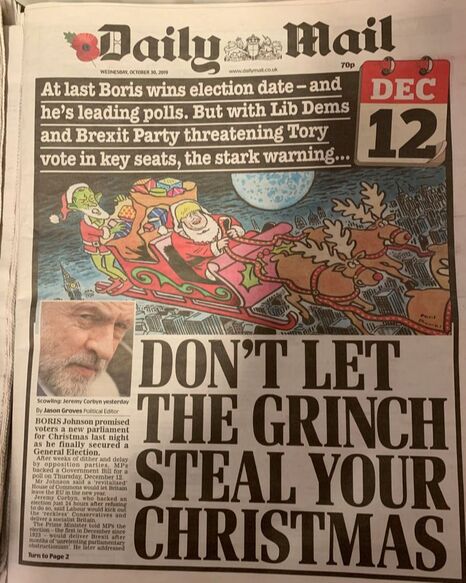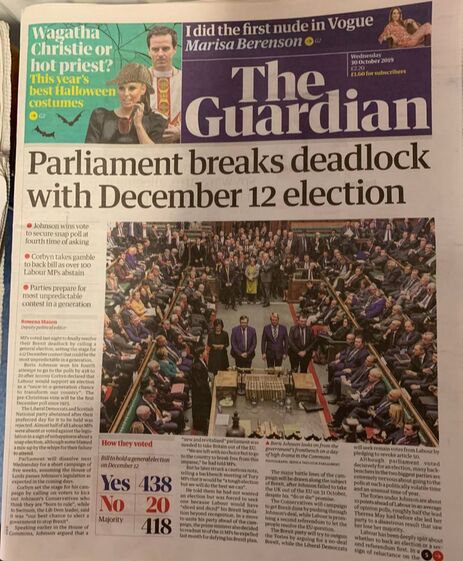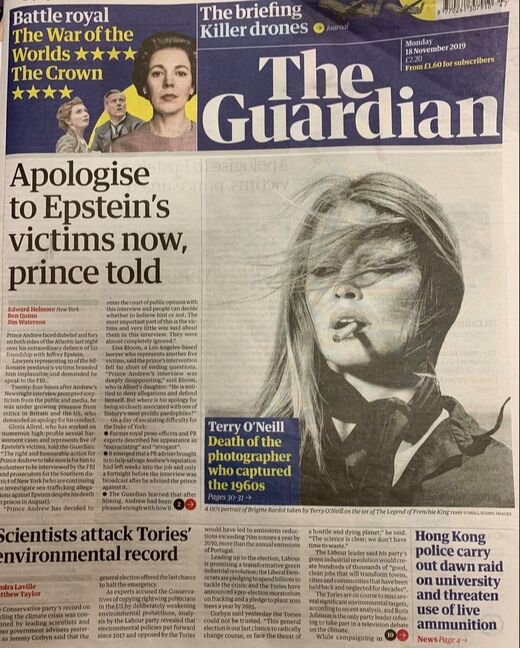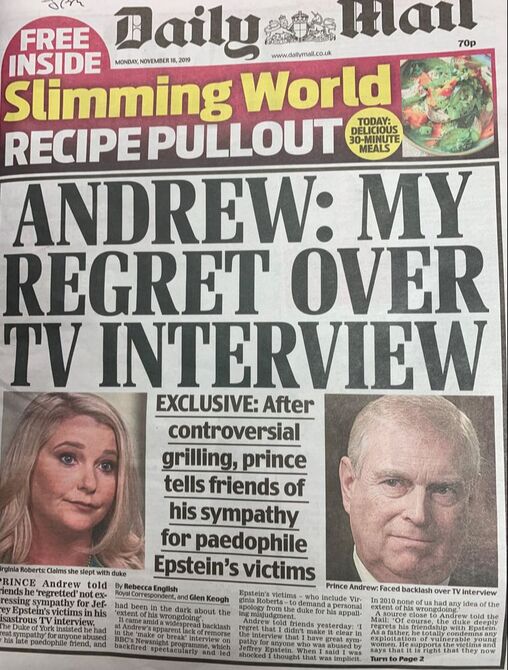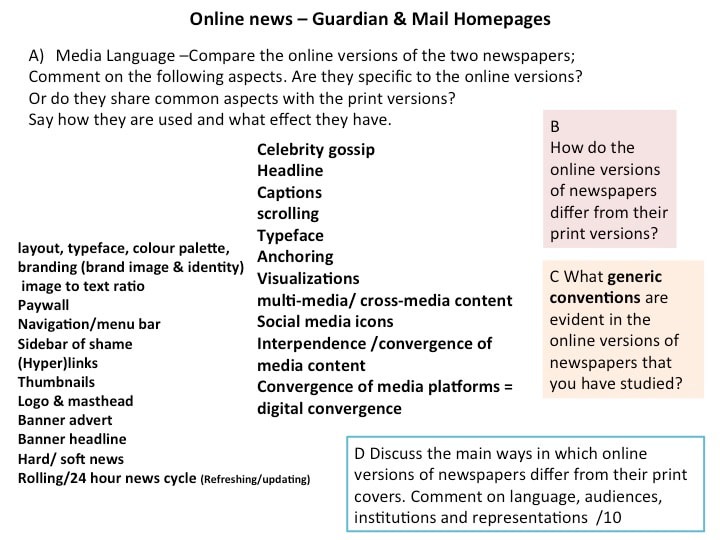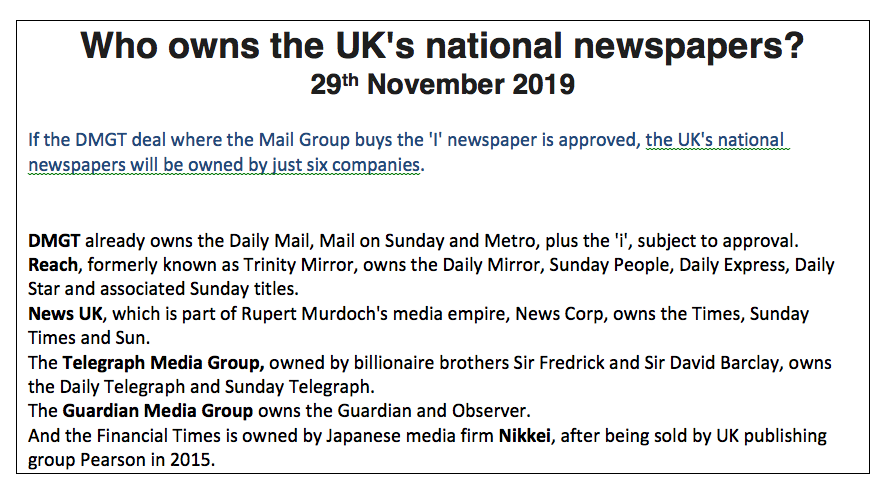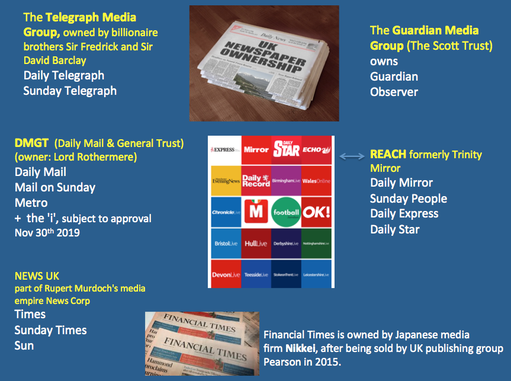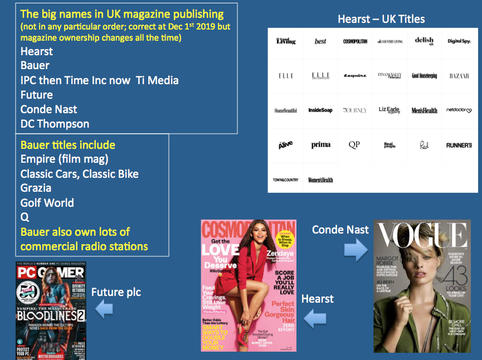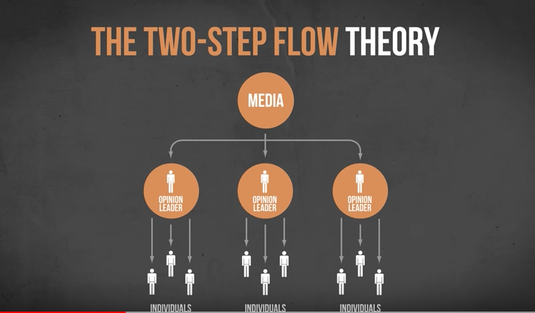Paper 1 Media Messages Section A: News
2 linked in-depth studies that focus on contemporary news in the UK; we explore how and why newspapers and their online counterparts are evolving as media products + the relationship between both online and offline news. Select 2 covers of The Mail cover+ 2 covers of The Guardian. + 1 full edition of each. News stories should be related, i.e. from the same day.
2 linked in-depth studies that focus on contemporary news in the UK; we explore how and why newspapers and their online counterparts are evolving as media products + the relationship between both online and offline news. Select 2 covers of The Mail cover+ 2 covers of The Guardian. + 1 full edition of each. News stories should be related, i.e. from the same day.
EXAM STYLE QUESTIONS
SECTION A PRINT FRONT PAGES
11) Link the covers to a) Moral Panics (Stanley Cohen) , b) Gaze Theory (Laura Mulvey), c) Female Objectification (John Berger)
SECTION B ONLINE NEWSPAPER NEWS
SECTION A PRINT FRONT PAGES
- Compare and contrast the C&Cs (Codes & Conventions) on a tabloid and broadsheet front pages. How are they used to appeal to particular audiences?
- Discuss and compare the representations on 2 contrasting front pages.
- Show how the covers often present news events as a 'narrative' – a constructed story to arouse opinion, emotion,controversy and connect to other areas of media such as sport, celebrity, TV/film.
- Discuss how the covers fit into concepts of genre (Neale, Lacey);
- To what extent do the covers feature stereotypes?
- What do the covers tell us about newspaper ownership? Refer to Hesmondhalgh, Curran & Seaton.
- Link the front pages to theories of patriarchy. Refer to theorists such as Liesbet Van Zoonen, Judith Butler.
- Link the front pages to theories of one of the following: A) HALL (encoding/decoding; 3 readings) B) GERBNER (Cultivation Theory, Mean World Syndrome)
- What do the covers tell us about issues of regulation and control? Refer to the Leveson enquiry and press complaints organisations such as IPSO. Refer to Livingstone and Lunt.
- How important are consumerism and commodification on the front covers shown here?
11) Link the covers to a) Moral Panics (Stanley Cohen) , b) Gaze Theory (Laura Mulvey), c) Female Objectification (John Berger)
SECTION B ONLINE NEWSPAPER NEWS
- How does the Mail Online hook its audiences? What are the similarities and differences with the print edition?
- Analyse the Mail Online's 'sidebar of shame'. What do the items have in common in terms of the way women are represented? – look for examples of objectification, body-shaming, women as male fashion accessories; women as eye-candy; women as coat-hangers; women as child-bearers.
- Analyse the Guardian's Online presence. What pop-up messages are used to appeal to audiences for financial support?
- How do the online platforms of tabloid and broadsheet newspapers differ from the print editions? Consider audience, technical codes, immediacy and access.
- Look at the Guardian's Facebook, Twitter and Instagram posts – how do they reflect the target readership? Do you think do they give prominence to users' opinions rather than the views of experts? (Refer to Clay Shirky)
- Look at the Mail's Facebook, Twitter and Instagram posts – how do they reflect the target readership? Do you think do they give prominence to users' opinions rather than the views of experts? (Refer to Clay Shirky)
PAPER 1 SECTION A NEWS - PRINT & ONLINE: IN-DEPTH STUDY. THEORY IS NEEDED FOR THIS SECTION
here are 4 suggested front pages you can use: 30 oct 2019 + 18 nov 2019
OR click here for election day covers from friday 13th december 2019
Vertical Divider
Vertical Divider
Vertical Divider
| print terms & learning recap.docx | |
| File Size: | 136 kb |
| File Type: | docx |
Vertical Divider
|
Vertical Divider
news & theorists HANDOUT
_____________________________________________________________
HEGEMONY SLIDESHOW
| |||||||||||||
_________________________________________________________________
| |||||||||||||||||||||||||||||||
| GUARDIAN Online article analysis .pdf | |
| File Size: | 1408 kb |
| File Type: | |
| MAIL Online article analysis example pdf 2.pdf | |
| File Size: | 2085 kb |
| File Type: | |
IN FEB/MARCH, YOU WILL NEED TO FIND TWO MORE ONLINE ARTICLES OF YOUR OWN: ONE FROM THE MAIL ONLINE AND ONE FROM THE GUARDIAN.COM
______________________________________________________________________________________________________________________________________________________________________
______________________________________________________________________________________________________________________________________________________________________
| uk press revision ppt version | |
| File Size: | 115 kb |
| File Type: | pptx |
Vertical Divider
| uk press revision pdf version | |
| File Size: | 90 kb |
| File Type: | |
| feminist theory intro.pdf | |
| File Size: | 9693 kb |
| File Type: | |
| frontpage analysis +sample qus.pptx | |
| File Size: | 6902 kb |
| File Type: | pptx |
Vertical Divider
Vertical Divider
|
Look at this Clay Shirky TED talk video- How Social Media can Make History Answer these questions: 1) What has replaced the 'one to many' broadcast model? 2) He talks about the corrective/ collective/ fragmenting power of the internet 3) It's not just about conversations, it's about collaboration and parsnips/ partners/participation. 4) Audiences are not just consumers, they have become .... 5) What example does he give to show the power of ordinary citizens over official government-controlled media? 6) What is the name of China's main internet organisation? 7) Citizen journalism in China led to the rapid growth of donation sites followed by a backlash against which group of people and why? 8) What is the term for China's official censorship policy? The Great ..... 9) Media is: global, social, ................... and cheap. 10) For Shirky, the important thing is that audiences can a) listen b) talk back c) destroy governments 11) In the modern media landscape, there are more ...................... than professionals. 12) In Obamas's presidential campaign, what was the issue that brought audiences closer to Obama, showing the effectiveness of dialogue? Follow up work A) Comment on Shirky's views. Doe you think he is exaggerating the extent to which audiences are participants in the democratic process? B) Look up the Arab Spring (Tunisia) 2011 and the role of social media and try to get a picture of the extent to which social media played a role. C) Look at MBK (My Brother's keeper) campaign and Black Lives Matter. To what extent are these good examples of the many to many participatory model? D) Describe one other example of citizen journalism: #metoo ? everyday sexism project? |
Vertical Divider
|
Vertical Divider
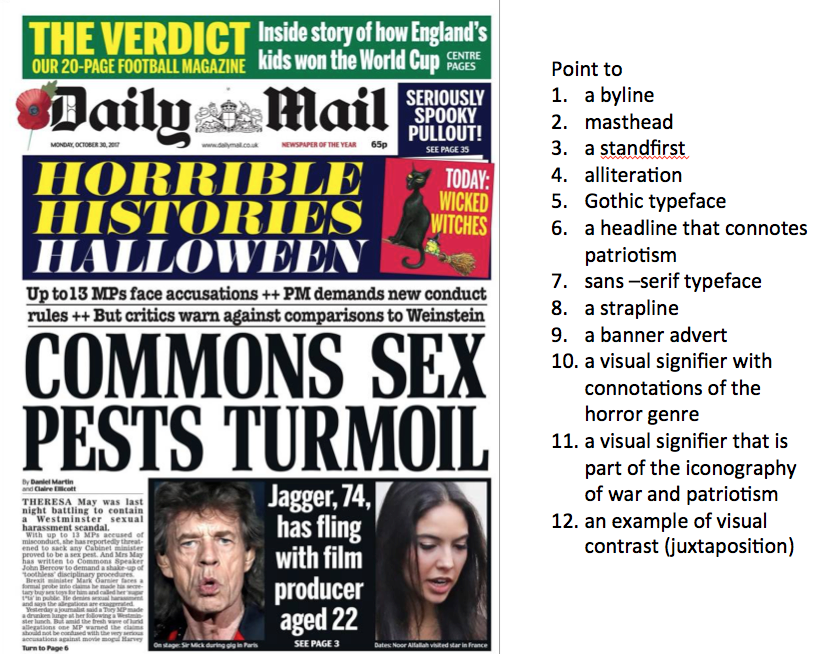
2 news values models -
1) galtung & ruge (a more traditional approach)
2) Noam Chomsky ( A MORE MODERN NEO-MARXIST APPROACH)
GALTUNG & RUGE NEWS VALUES
GALTUNG & RUGE Their research found that several key factors determine news agendas (i.e the factors that determine what news organisations consider to be newsworthy). The main factors are:
Scale - how big the event is (numbers of victims, damage etc)
Proximity - closeness to home
Personalization - a individual human story that sums up a more complex bigger issue
Elites - something that affects powerful nations or people
Unexpectedness - originality, surprise.
Expectedness - an event that is part of an ongoing narrative e.g. transport disruption following bad weather.
Negativity - for commercial media organisations 'bad news is good news'
(SEEN PUP will help you remember these)
Scale - how big the event is (numbers of victims, damage etc)
Proximity - closeness to home
Personalization - a individual human story that sums up a more complex bigger issue
Elites - something that affects powerful nations or people
Unexpectedness - originality, surprise.
Expectedness - an event that is part of an ongoing narrative e.g. transport disruption following bad weather.
Negativity - for commercial media organisations 'bad news is good news'
(SEEN PUP will help you remember these)
noam chomsky's 5 news filters
Outlined in 'Manufacturing Consent- The Political Economy of the Mass Media' (Herman & Chomsky 1988)
For Chomsky, media organisations select, construct and re-present news to reflect and protect the interests of large corporations.
So the way they select, construct and 'package' news depends on 5 factors or filters reflecting an awareness of:
For Chomsky, media organisations select, construct and re-present news to reflect and protect the interests of large corporations.
So the way they select, construct and 'package' news depends on 5 factors or filters reflecting an awareness of:
- advertisers ( the main source of funding. He called this 'sourcing)
- owners
- other large corporations
- critics (which he called 'flak')
- an anti-communist / & now a counter-terrorist agenda
Vertical Divider
